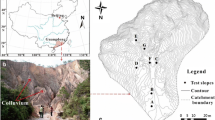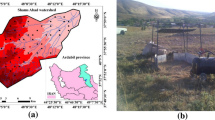Abstract
Simulated rainfall is a valid tool to examine the runoff generation on the slope. 13 simulated rainfall experiments with different rainfall intensities and durations are completed in a 5 m × 10 m experimental plot in mountainous area of North China. Simultaneously, rainfall, surface runoff, soil-layer flow, mantel-layer flow and soil moisture are monitored respectively. From the results, it is found that the hydrographs in all layers have the characteristics of rapid rise and fall. The recessions of surface flow and soil-layer flow are much faster than that of mantel-layer flow. Surface flow, the main contributor, makes up more than 60% of the total runoff in the study area. It even exceeds 90% in the cases of high intensity rainfall events. Runoff coefficient (ratio of total runoff to rainfall amount) is mainly influenced by rainfall amount, rainfall intensity and antecedent soil moisture, and the relationship can be well expressed by a multiple linear regression function α = 0.002P + 0.182i + 4.88W a − 0.821. The relation between the rainfall intensity and the lag time of three flows (surface runoff, soil-layer flow and mantel-layer flow) is shown to be exponential. Then, the result also shows that the recession constant is 0.75 for surface runoff, is 0.94 for soil-layer and mantel-layer flow in this area. In this study area, the dominant infiltration excess runoff is simulated by Horton model. About 0.10 mm/min percolation is observed under the condition of different rainfall intensities, therefore the value is regarded as the steady infiltration rate of the study area.
Similar content being viewed by others
Explore related subjects
Discover the latest articles and news from researchers in related subjects, suggested using machine learning.References
Barnes B S, 1939. The structure of discharge recession curves. Trans. Amer. Geophys. Union., 20(4): 721–725.
Cai Q G et al., 1996. Experimental study of soil erosion and sediment yield on slopeland of red soil derived from granite. Journal of Sediment Research, 10: 89–96. (in Chinese)
Chen H S, Shao M G, Li Y Y, 2008. The characteristics of soil water cycle and water balance on steep grassland under natural and simulated rainfall conditions in the Loess Plateau of China. Journal of Hydrology, 360(1–4): 242–251.
Cristina R M et al., 2006. Rainfall simulations on a fire disturbed Mediterranean area. Journal of Hydrology, 327(3/4): 323–338.
Horton R E, 1933. The role of infiltration in the hydrologic cycle. American Geophysical Union Transactions, 14: 446–460.
Jordan A, Martinez-Zavala L, 2008. Soil loss and runoff rates on unpaved forest roads in southern Spain after simulated rainfall. Forest Ecology and Management, 255(3/4): 913–919.
Kato H, Onda Y, Tanaka Y, Asano M, 2009. Field measurement of infiltration rate using an oscillating nozzle rainfall simulator in the cold, semiarid grassland of Mongolia. CATENA, 76(3): 173–181.
Leighton-Boyce G, Doerr S H, Shakesby R A et al., 2007. Quantifying the impact of soil water repellency on overland flow generation and erosion: A new approach using rainfall simulation and wetting agent on in situ soil. Hydrological Process, 21(17): 2337–2345.
Leonard J, Andrieux P, 1998. Infiltration characteristics of soils in Mediterranean vineyards in Southern France. CATENA, 32(3–4): 209–223.
Liu C M, 1966. A discussion on the method on soil erosion in the cropland on the slopes in the loess. Acta Geographica Sinica, 32(2). (in Chinese)
Liu C M, Hong B X, Zeng M X, 1965. A primary study on the forecasting of relationship on heavy rainfall-runoff in the Loess Plateau. Chinese Science Bulletin, 2(2): 158–161 (in Chinese)
Liu C M, Liu C T, 1981. Relationship between soil water dynamic and its rainfall-runoff in the loess zone. Mem. of Geogr. Beijing: Science Press, No.12: 61–73. (in Chinese)
Mein R G, Larson C L, 1973. Modeling infiltration during a steady rain. Water Resource Research, 9(2): 384–394.
Shen B, Wang W Y, 1993. Effects of sparse vegetation on runoff formation processes on the loess slope. Journal of Soil and Water Conservation, 7(1): 23–28. (in Chinese)
Tallaksen L M, 1995. A review of baseflow recession analysis. Journal of Hydrology, 165(1–4): 349–370.
Wu C W, Wang L X, 1995. The analysis on the characteristics of infiltration and its simulating into forested land. Research of Soil and Water Conservation, 2(1): 71–75. (in Chinese)
Wu Q X, Zhao H Y, Wang Y K, 1998. Flow production and sediment production and their processes in Chinese Pine woodlands in the Loess Plateau. Acta Ecologica Sinica, 18(2): 151–157. (in Chinese)
Yang J Y, Zhao Y N, Sun B P et al., 1993. Kinematic wave theory and its application in slope runoff simulation. Journal of Beijing Forestry University, 15(1): 1–11. (in Chinese)
Zhang G H, Jiang D S, Shao M G, 2001. Runoff processes simulation on land based on unsaturated soil physical properties. Journal of Mountain Science, 19(1): 14–18. (in Chinese)
Zhang Z Q, Wang L X, Yu X X et al., 2000. Effective overland roughness coefficient calculation for forested infiltrating slope. Scientia Silvae Sinivae, 36(5): 22–27. (in Chinese)
Author information
Authors and Affiliations
Corresponding author
Additional information
Foundation: National Natural Science Foundation of China, No.40371025
Author: Yu Jingjie (1964–), Professor, specialized in hydrological sciences.
Rights and permissions
About this article
Cite this article
Yu, J., Yang, C., Liu, C. et al. Slope runoff study in situ using rainfall simulator in mountainous area of North China. J. Geogr. Sci. 19, 461–470 (2009). https://doi.org/10.1007/s11442-009-0461-x
Received:
Accepted:
Published:
Issue Date:
DOI: https://doi.org/10.1007/s11442-009-0461-x




